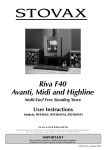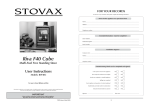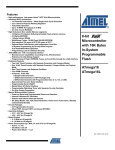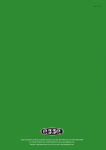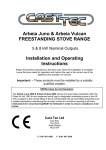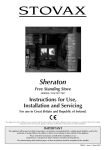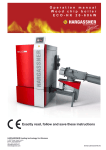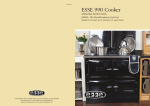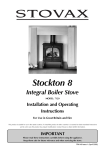Download Yeoman YM-CKWDPB-R Operating instructions
Transcript
Solid Fuel Cooker INSTALLATION & OPERATING INSTRUCTIONS Models YM-CKWDWH-R / YM-CKWDBL-R YM-CKWDGR-R / YM-CKWDPB-R / YM-CKWDWH-L YM-CKWDBL-L / YM-CKWDGR-L / YM-CKWDPB-L For use in Great Britain and Eire This product is suitable for use in the stated countries. To install the product in other countries it is essential to obtain translated instructions and in some cases the product may require modification. Contact Yeoman to obtain further details. IMPORTANT The front and top of this cooker will become hot whilst in operation, it is therefore recommended that a suitable guard should be used for the protection of young children, the elderly or infirm. Before installation of this product please read these instructions fully. The installer should complete the commissioning sheet at the start of the User Instructions PM179 Issue 1 (October 2006) Contents Commissioning Data 3 Technical Specification 4 SITE REQUIREMENTS Solid Fuel Cooker Dimensions Hearth Dimensions Walls adjacent to Hearths 5 5 5 PRE-INSTALLATION CHECKS Flue or Chimney Additional Ventilation 7 8 INSTALLATION INSTRUCTIONS Installing the Cooker Commissioning 9 10 USER INSTRUCTIONS General Care of the Cooker Using the stove for the first time Burning Wood Burning Solid Fuel Over Firing Oven Temperature Seasonal Use Ash Removal Recommended Fuels 11 11 11 12 12 13 13 13 13 14 MAINTENANCE AND SERVICING General Cleaning Cleaning Glass Chimney Sweeping Annual Service 15 15 15 15 2 FOR YOUR RECORDS To assist us in any Guarantee claim please complete the following information:- YEOMAN DEALER APPLIANCE WAS PURCHASED FROM Name: .................................................................................................................................................................................................. Address:............................................................................................................................................................................................... ............................................................................................................................................................................................................. Telephone number: .................................................................................................................................................... ESSENTIAL INFORMATION - MUST BE COMPLETED Date installed:...................................................................................................................................................................................... Model Description: .............................................................................................................................................................................. Serial number: .......................................................................................................................................................... INSTALLATION ENGINEER Company name:................................................................................................................................................................................... Address:............................................................................................................................................................................................... ............................................................................................................................................................................................................. Telephone number: .................................................................................................................................................................... COMMISSIONING CHECKS (TO BE COMPLETED AND SIGNED) Is flue system correct for the appliance YES NO Flue swept and soundness test complete YES NO Smoke test completed on installed appliance YES NO Spillage test completed YES NO Use of appliance and operation of controls explained YES NO Instruction books handed to customer YES NO Signature: ........................................................................................................ 3 Print name: ...................................................... TECHNICAL SPECIFICATION Model 3 Solid fuel cooker Nominal heat output All fuels Flue draught @ nominal heat output All fuels KW 7.5 mm Wg 1.00 inch Wg 0.04 mm 125 inch 5 mm 125 inch 5 mm 125 inch 5 Kg 120 Top Rear Flue outlet size Side Weight Wood Seasoned wood (less than 20% moisture content) Solid fuel Briquetted smokeless fuel suitable for closed appliances. (Ancit – Phurnacite – Taybrite – Homefire ovals) Recommended fuels Top Flue Top Plate Fire Door Flue By-pass Ash Door Side Flue Air Control Warming Drawer Oven Cleaning Cover 4 SITE REQUIREMENTS The Solid fuel cooker should be fitted by a HETAS (GB only) registered installer, or approved by your local building control officer. Your Stovax dealer should be able to arrange this service for you. Before installation of this product please read these instructions fully. It is very important to also understand the requirements of the UK Building Regulations (England and Wales – Document J / Scotland - Part F), along with any local regulations, and working practices that may apply. Should any conflict occur between these instructions and these regulations then the regulations shall apply. Your building insurance company may also require you to inform them that you have installed a new heating appliance, so check with your insurers that your cover is still valid after installing the Solid fuel cooker. When completing the installation and building works you should comply with your responsibilities under the Health and Safety at Work Acts, and any new regulations, which may be introduced during the lifetime of these instructions. All electrical connections should meet the requirements of UK Building Regulations (England and Wales – Document P / Scotland - Part N). Your local Building Control Office would be happy to advise should questions arise, regarding the requirements of the regulations. SOLID FUEL COOKER DIMENSIONS A faulty installation could cause danger to the inhabitants and structure of the building. (Right hand cooker shown) Top Flue Top Flue Additional information covering the installation the Solid fuel cooker may be found in the following British Standard: BS8303. 5 SITE REQUIREMENTS HEARTH DIMENSIONS The appliance must stand on a constructional hearth with the minimum dimensions as shown in diagram below. If you are fitting the appliance into an existing hearth setting check that it complies with the current construction regulations and is the minimum sizes shown. control officer. Masonry chimney systems built with clay or concrete liners or pre-fabricated block systems should be constructed in accordance with BS 6461 : Part 1. Factory made insulated systems should comply with BS 4543 : Part 2 and be installed to BS 7566 : Parts 1 to 4. If you have no existing fireplace or chimney, it is possible to construct a suitable non-combustible housing and hearth setting. However this should be constructed to comply with the requirements of both current national and local regulations with the design approved by your local building Remember that any new chimney added to your property may also require planning permission. 6 SITE REQUIREMENTS WALLS ADJACENT TO HEARTHS Location of hearth or Solid fuel cooker Solid, non combustible material Thickness (W) height (A) Where the hearth abuts a wall and the solid fuel cooker is not more than 50mm from the wall 200mm At least 300mm above the solid fuel cooker and 1200mm above the hearth(Use the largest value) Where the hearth abuts a wall and the appliance is more than 50mm but not more than 300mm from the wall 75mm At least 300mm above the solid fuel cooker and 1200mm above the hearth (Use the largest value) Where the hearth does not abut a wall and is no more than 150mm from the wallSee note below 75mm At least 300mm above the hearth Note: there is no requirement for protection the wall where C is more than 150mm 7 PRE-INSTALLATION CHECKS 1.3 A flexible flue liner system may be used, if it is independently certified for use with Solidfuel systems, and is installed according to the manufacturer’s instructions and the requirements of Building Regulations. If an appliance is been replaced on an existing flexible flue liner system, the liner system should be replaced, unless it can be proved to be recently installed and can be seen to be in good condition. 1. Flue or Chimney 1.4 The construction of the Flue or Chimney system should meet the requirements of the Building Regulations with sizes as shown: - The flue exit from the building should be positioned to comply with the requirements of the Building Regulations. 1.5 Any existing flue should be confirmed as suitable for the new intended use, as defined in the Building Regulations. 1.6 Any existing flue or chimney system must be inspected and swept by a NACS registered (UK only) chimney sweep, to confirm that the system is structurally sound and free from any obstructions. It is important that adequate ventilation exists and the Flue or Chimney system that is to be used is in good working condition. Products of combustion that enter the room could be a serious health risk. Before installation of this product the Flue or Chimney system and Ventilation requirements are inspected by a competent person, and passed as suitable for use with the appliance to be fitted. In particular the following should be checked: - Model Solid fuel cooker Without liner system Round (diameter) Flue / Chimney size Without liner system (square) minimum dimension With liner or factory made system (diameter) installed in accordance with manufactures instructions Flue / Chimney minimum height * mm 150 inch 6 1.7 Suitable access should be provided to enable the collection and removal of debris. mm 135 1.8 inch 5 1/2 Provision should be made to sweep and inspect the flue when the appliance is installed. 1.9 mm 150 No other heating appliances should be connected to, or share, the same Flue or Chimney system. inch 6 m 4 feet 13 1.10 Check the flue draught. This should be done with all windows and doors closed and any extraction fans in this or adjoining rooms running at maximum speed. (See next section for additional ventilation requirements) Note: A guide containing general information on Chimneys and Flues is obtainable from: - *When measured from the top of the cooker to the top of the flue, with no horizontal sections and a maximum of 4 bends with angles of less than 45° 1.1 An, approved, factory made system suitable for Solidfuel use, complying with BS 4543: Part 2, may be used when installed to the requirements of BS 7566: Parts 1 to 4, the manufacturer’s instructions and the requirements of Building Regulations. 1.2 New masonry chimney systems built with clay or concrete liners or pre-fabricated block systems should be constructed in accordance with BS 6461: Part 1, and the requirements of Building Regulations, may be used. The British Flue & Chimney Manufacturers’ Association, FETA 2 Waltham court Milley lane Hare hatch Reading Bucks RG10 9TH Tel : - 01189403416 8 e-mail :- [email protected] PRE-INSTALLATION CHECKS 1.11 Where a hearth, fireplace, flue or chimney is provided or extended (including cases where a flue is provided as part of refurbishment work), information essential to the correct appliance and use of these should be permanently posted in the building, to meet Requirement J4 of the Building Regulations (England and Wales), F3.12 (Scotland). 2. Additional Ventilation 2.1 Additional ventilation will be required to comply with the requirements of the Building Regulations. This should be provided using a permanently open air vent, of the size listed, which is positioned so that it is not liable to be blocked both inside and outside the building. Model Additional ventilation Solid fuel cooker mm2 1375 cm2 13.75 sq. inch 2.125 2.2 Extractor fans or cooker hoods should not be placed in the same room or space as the appliance. 2.3 If any of these checks reveal problems do not proceed with the fitting of the appliance until they have been rectified. 9 INSTALLATION INSTRUCTIONS Because each installation is unique to the property, it is not possible to give full details to suit every setting. However the installation should comply with the requirements of the Building Regulations and be made using “best practice” construction methods. 1.5 Decide it the installation is to be top, rear or side flue exit, and fit and seal, with fire cement, the flue collar and blanking plate to suit. The flue collar attaches to the cooker backplate or top plate with fixings supplied. The blanking plates are fixed to the unused flue outlets with fixings supplied. 1.6 Lift the cooker into position on the prepared hearth area, taking care not to damage the hearth finish. 1.7 Level cooker using adjustable feet. 1.8 Connect the cooker to the chimney system, using Stovax enamelled flue pipe and seal the connecting joints. Typical top, rear or side flue connections are shown. 1.9 Provision must be made to clean the flue/chimney after the cooker is installed, as it is not possible to clean through the cooker when it is installed. Remember that many fireplace openings will have a supporting lintel. Do not remove this without making provision to support the remaining structure of the building. The Solid fuel cooker must not form any part of the supporting structure. 1. INSTALLING THE COOKER 1.1 Remove all packing and temporary transportation fixings from the Solid fuel cooker, check that no parts have been left inside the cooker. 1.2 Take care handling the cooker as it is possible damage the enamel finish. The hot plate area may be removed to reduce the weight, but take care not to damage any seals, and beware of any sharp edges when handling the cooker or any parts. 1.3 If the cooker is to be placed between combustible work surfaces and cupboards the optional, insulating, side panels must be fitted. Stovax Part No. YM-CKSPWH YM-CKSPBL YM-CKSPGR YM-CKSPPB YM-CKSPINT 1.4 Description Yeoman SF Cooker Insulation Panel 5cm White Yeoman SF Cooker Insulation Panel 5cm Blue Yeoman SF Cooker Insulation Panel 5cm Green Yeoman SF Cooker Insulation Panel 5cm Pebble Yeoman SF Cooker Integral Insulation Panel The clearance to any side wall and the firebox side of the cooker should be a minimum of 50mm, to allow the firedoor to open fully. 1.10 Provision should be made for flue debris collection and cleaning when the cooker is installed. 10 INSTALLATION INSTRUCTIONS 1.11 Rear or side flue pipe installation 1.15 Connect a flue pipe 612mm long (Stovax part no 4501 (5” pipe)) by inserting it into the flue spigot and sealing using fire cement. 5” Flue Pipe (Stovax Part No. 4501) 2. COMMISSIONING 2.1 5” Tee (Stovax Part No. 4516) Before lighting the Solid fuel cooker, check the following items: a) Fit of internal parts (firegrate, firebricks, baffles, and log retainer). b) Door alignment, seals and catch operation. c) Operation of air controls. d) Operation of riddling grate system. e) Check no items have been left in the warming drawer, oven, firebox and ashpan. 1.12 Connect a tee (Stovax part no 4516 (5” pipe)) by inserting it into the flue spigot and sealing using fire cement. The cap supplied with the tee is used as the cleaning access. 1.13 Side flue installation will require the use of an extension flue pipe to enable correct fitting of tee (Stovax part No. YM-CKADAP). 2.2 If there are any problems with the fit or operation of any of these items this should be corrected before continuing with the commissioning of the Solid fuel cooker. 2.3 Carry out a final smoke draw test, by first warming the flue with a blowlamp, or similar, for about 10 minutes. Then place a smoke pellet on the centre of the grate, with the air controls open, and close the door. Smoke should now be drawn up the flue and be seen to exit from the flue terminal. This test should be completed with all doors and windows in the room where the Cooker is fitted closed. Should this test fail the suitability of the flue system and ventilation should be re-checked. 2.4 Light the appliance and gently allow the temperature to increase slowly to operating levels. Check that no combustion products are entering the room. When the Cooker has reached a steady operating condition open the main firedoor and carry out a spillage test with a smoke match or pellet around the door opening. 2.5 If excessive spillage does occur allow the appliance to cool and re-check the suitability of the flue system and ventilation. 2.6 Explain the safe operation of the cooker and the use of the controls to the user, along with the need to only use suitable fuels. Also explain the cleaning and routine maintenance requirements. 2.7 Explain the requirements to use a suitable protection when children, elderly or infirm persons may be near the appliance. 2.8 Record dealer/supplier details and installer details in user instructions. 1.14 Top flue pipe installation 5” Flue Pipe (Stovax Part No. 4501) 11 INSTALLATION INSTRUCTIONS 2.9 Record serial number in user instructions. This number will be required when ordering spare parts and making warranty claims. 2.10 Give the copy of the user instructions to the customer. 12 USER INSTRUCTIONS 1. GENERAL 1.1 1.2 This cooker is designed for domestic use and should only be used for this purpose, and in accordance with the manufacturers operating instructions. It should be installed by a competent installer (HETAS registered UK only), in accordance with all local regulations, including those referring to national and European standards. 1.3 The cooker should only be used to burn approved fuels and should not be used with liquid fuels or used as an incinerator. 1.4 As with all cookers the surfaces will become very hot when in use, therefore due care should be taken when near the cooker. If it is to be used in the presence of young children, elderly or infirm persons a suitable fireguard should be used. Care should also be taken with the placement of combustible items near the cooker as conducted and radiated heat could cause a fire hazard. 1.5 Stovax offer a hearthgate system designed to offer full protection for cookers and fireplaces. Your Stovax dealer can advise you on these products. 1.6 The additional ventilation required for the safe use of this cooker should be kept free of any obstructions, both inside and outside the building, at all times. 1.7 Your Stovax product should be serviced annually by a competent service engineer, and if repairs are required use only Stovax approved spare parts. 1.8 Do not make unauthorised modifications or changes to the cooker. 1.9 SERIAL NUMBER You will get better results if you clean your cooker when it is cool. 2.6 VITREOUS ENAMEL FINISH CLEANING THE HOTPLATE Burnt-on food may be removed by carefully using a plastic scraper or plastic cleaning pad when the cooker is cool. Use hot soapy water and a cloth to clean and finish with a soft dry cloth. Some light surface rust may occasionally appear on the hot plate, this may be removed by using a cleaning pad and polishing with a small amount of cooking oil. 2.8 CLEANING THE OVEN The internal surfaces of the oven are finished with vitreous enamel. These may be cleaned using a nonabrasive oven cleaner and any burnt-on food may be removed by carefully using a plastic scraper or plastic cleaning pad when the cooker is cool. The door glass may be cleaned by using Stovax glass cleaner and a soft cloth. Then wipe with warm soapy water and a cloth, to neutralise any remaining cleaner, and finish with a soft dry cloth. 3. USING THE COOKER FOR THE FIRST TIME NEVER use caustic, citric or abrasive cleaning products on your cooker because these may scratch or damage its surfaces. 2.3 We recommend you allow your cooker to cool fully before cleaning and carrying out any maintenance work. Some natural discolouration and marking of the hot plate will occur during use of the cooker. IMPORTANT ALWAYS try to wipe up spillages when they happen. 2.5 2.7 2. CARE OF THE COOKER 2.2 Use hot soapy water and a cloth to clean the enamel surfaces and finish with a soft dry cloth to avoid streaking. The coloured surfaces of the cooker are finished in vitreous enamel. Care should be taken as this finish can be damaged by dropping objects onto surfaces or cleaning with metal scrapers or wire wool. Burnt-on food may be removed by carefully using a plastic scraper or plastic cleaning pad when the cooker is cool. This number will be required when ordering spare parts or making warranty claims. 2.1 2.4 3.1 When new, it is best to burn the cooker at a low output for the first few days of use. This will allow the construction to settle and all fixing glues and paint to fully cure. 3.2 Avoid touching any painted finish during the first period of use. 13 USER INSTRUCTIONS 3.3 During this time the cooker may give off some unpleasant odours, and we recommend that you keep the room well ventilated during this period to avoid a build-up of fumes. 4.9 Allow the new logs to burn at high output for a few minutes before adjusting the burn rate, with the air control, to the desired setting. It is best to refuel little and often to maintain clean and efficient burning. 4.10 The ideal control settings to suit the particular installation and personal preferences will be established by experience in using the cooker. 4. BURNING WOOD 4.11 It is not recommended to load large amounts of logs and burn with the air control on low settings for long periods of time. This will cause large a build-up of tars and creosotes in the cooker and flue system, possibly resulting in a chimney fire. Air Control (min) (max) 4.12 Do not burn kiln-dried, painted, impregnated wood or manufactured board products. As the high combustion temperatures generated by these products could cause permanent damage to the internal parts of the cooker. Flue By-pass 5. BURNING SOLID FUEL CLOSED To back Air Control (min) OPEN To front 4.1 Open the air control to maximum. 4.2 Open flue by-pass control using tool. 4.3 Place some pieces of firelighter or dry crumpled paper on the grate and cover with some small pieces of dry kindling wood. Light the paper or firelighters. (max) Flue By-pass CLOSED To back 4.4 As the fire becomes established add larger pieces of wood. Do not leave the firedoor open as this could over-fire the cooker and cause permanent damage. 4.5 As the fire becomes established adjust the air control to give the oven temperature you require. 4.6 Close flue by-pass control. 5.1 Open the air control to maximum. 4.7 To burn wood efficiently it is best to allow a bed of ash to build-up on the grate. 5.2 Open flueby-pass control using tool. 5.3 Place some pieces of firelighter or dry crumpled paper on the grate and cover with some small pieces of dry kindling wood. Light the paper or firelighters. 5.4 As the fire becomes established add larger pieces of wood. Do not leave the firedoor open as this could over-fire the cooker and cause permanent damage. 4.8 OPEN Before re-fuelling the cooker it is advisable to first rake the embers evenly over the firebed then open the air control fully for a few minutes, to establish a glowing bed before adding new logs. 14 To front USER INSTRUCTIONS 5.5 As the fire becomes established adjust the air control to give the oven temperature you require. 5.6 Close flue by-pass control. 5.7 Before re-fuelling the cooker it is advisable to first deash the firebed, using the riddling grate system or a suitable poker. Do not use bare hands to operate the riddling system or using a poker to clear the firebed. 5.8 Then open the air control fully for a few minutes, to establish a glowing bed before adding new fuel. Allow the new fuel to burn at high output for a few minutes before adjusting the burn rate with the air control to the desired setting. It is best to refuel little and often to maintain clean and efficient burning. 5.9 The ideal control settings to suit the particular installation and personal preferences will be established by experience in using the cooker. 7. OVEN TEMPERATURE 7.1 Oven Temperature °C 5.10 Do not burn bituminous coal, ‘petro-coke’ or other petroleum based fuels, as this will invalidate and product guarantee. 8. SEASONAL USE 6. OVER-FIRING 6.1 Do not use the cooker at maximum output for prolonged periods of time, or over fill the firebox with fuel, as this could result in over-firing. If the connecting fluepipe, appliance flue collar or top plate glow red with heat the appliance is been over-fired and the air controls should be closed to reduce the output. 6.2 If a chimney fire occurs shut all air controls immediately to close the appliance down, and evacuate all persons from the building before calling the fire brigade. Do not re-enter the building until it is confirmed safe to do so. 6.3 Following a chimney fire do not use the appliance until it is inspected, by a HETAS (GB only) registered installer, to confirm that the appliance is safe to use, or make any repairs required before re-use. Only genuine Stovax replacement parts are to be used to keep your appliance in safe and efficient working order. 6.4 The oven temperature may be adjusted by changing the burn rate by turning the air control on the ashdoor, or adding fuel to increase the temperature. As with all solid fuel cookers the response to changes in control settings may be slow, and the ideal method of operation will be determined by experience. 8.1 If the cooker is not to be used during the warmer periods of the year it is recommended to clean and service the cooker, as detailed. 8.2 The air controls should be set in the 50% position to keep the appliance ventilated, and stop the build-up of any moisture inside. 8.3 Before re-lighting the cooker clear any debris that may have accumulated and check the flue is clear of any blockages. 9. ASH REMOVAL 9.1 After any chimney fire it is recommended that the chimney system be inspected and swept by a NACS registered (UK only) chimney sweep, to confirm that the system is structurally sound and free from any obstructions before re-use. 15 The burning of any fuel will produce ash, which will have to be removed after a period of use. This time will depend on the fuel used. Before removing the ash from the cooker it is advisable to let the fire burn down to a low level, or even go out completely. The ashpan can be removed from the cooker after opening the ashdoor. USER INSTRUCTIONS 9.2 The symptoms of poor performance related to wet wood include: - De-ash the firebed using the operating tool to riddle the grate and clear ash. • difficulty getting a fire going and keeping it burning well, • smoky fires with little flame, • dirty glass, • rapid creosote build-up in the chimney, • low heat output, • Short burn times, excessive fuel consumption and blue/grey smoke from the chimney. 10.3 It is not recommended to load large amounts of logs and burn with the air control on low settings for long periods of time. This will cause large a build-up of tars and creosotes in the cooker and flue system, possibly resulting in a chimney fire, The use of Stovax Protector chimney cleaner will also help to reduce this problem. 9.3 As heat can remain in the ash for a long period after use care must be taken when removing and carrying the full ashpan. We suggest that the ashpan be carried using gloved hands, or the ash is placed directly in to a Stovax ash caddie. 9.4 When burning wood the amount of ash will be smaller and may only need removal once every week. To do this, allow the fire to burn out and cool. It is best to leave a layer of ash in the cooker to form a bed for the new fire. 9.5 Do not place ash in a bin made from plastic or any other combustible material. 10.4 Solid fuel: - Burn manufactured smokeless fuels, listed as suitable for use with closed heating appliances. Do not burn bituminous coal, ‘petro-coke’ or other petroleum based fuels, as this will invalidate and product guarantee. 10.5 If you require advice on suitable solid fuels contact your local Approved Coal Merchant. Details can be obtained by ringing the Solid fuel Association advice line on Freephone 0800 600 000. Or their web site at www.solifuel.co.uk 10. RECOMMENDED FUELS 10.1 Wood:- Burn only seasoned timber, with a moisture content of less than 20%. In most cases, this would require drying cut wood for at least 12 to 18 months before use. Poor quality timber could cause low combustion efficiency, produce large amounts of harmful condensation, which could reduce the effectiveness of the combustion system, and ultimately the life of the cooker. 10.2 Do not burn kiln-dried, painted, impregnated wood or manufactured board products. As the high combustion temperatures generated by these products could cause permanent damage to the internal parts of the cooker. 16 MAINTENANCE and SERVICING 1.1 1.2 We would recommend that your Solid fuel cooker be cleaned fully on a regular basis, according to the level of use. Attention should be given to cleaning the flueways and removing ash. Regular cleaning and preventive maintenance will help give many years of safe use. Flue ways under the oven may be cleaned by removing covers as shown. Inner Cleaning Cover Do not use abrasive cleaner or cleaning pads. 3.1 We would recommend that to maintain the safe and efficient use of the appliance the flue / chimney is inspected and swept at least once a year, by a NACS registered (UK only) chimney sweep, to confirm that the system is clean, structurally sound and free from any obstructions. 4. ANNUAL SERVICE 4.1 Once a year it is recommended to inspect and clean the cooker as detailed: - 4.2 Carefully remove all of the following internal parts. Complete grate and ashpan, and vacuum clean any remaining ash and debris from the inside of the cooker. 4.3 The coloured surfaces of the cooker are finished in vitreous enamel. Care should be taken as this finish can be damaged by cleaning with metal scrapers or wire wool. Burnt-on food may be removed by carefully using a plastic scraper or plastic cleaning pad. Use hot soapy water and a cloth to clean and finish with a soft dry cloth. The internal surfaces of the oven are finished with vitreous enamel. These may be cleaned using a nonabrasive oven cleaner and any burnt-on food may be removed by carefully using a plastic scraper or plastic cleaning pad. Use hot soapy water and a cloth to clean and finish with a soft dry cloth. 4.4 After removing the outer cover by pulling free from the sprung retaining clips the inner cover can be removed after unscrewing the two, wingnut fixings. Care should be taken not to damage any seals. If seals are damaged they should be replaced before cooker is re-used. The external finish may be cleaned using warm soapy water and a soft clean cloth. Wipe dry with a soft clean cloth before re-lighting. Do not leave unit without drying, as this may cause rust. 2. CLEANING GLASS 2.1 2.4 3. CHIMNEY SWEEPING Outer Cleaning Cover 1.3 2.3 This can be done as follows. Allow the Solid fuel cooker to cool fully, never attempt to clean hot glass. Any deposits can be removed using a soft cloth and Stovax Glass Cleaner. Then wipe with warm soapy water and a cloth, to neutralise any remaining cleaner, and finish with a soft dry cloth. Before re-lighting the appliance, dry the glass fully. 2.2 1. GENERAL CLEANING While the correct use will generally keep the glass clean when the appliance is used you may sometimes need to clean the glass. 17 4.5 The door glass may be cleaned by using Stovax glass cleaner and a soft cloth. Then wipe with warm soapy water and a cloth, to neutralise any remaining cleaner, and finish with a soft dry cloth. 4.6 Clean the Grate parts with a wire brush, check for any damage and replace any damaged parts as required. 4.7 Check and clean, with a soft brush the Firebricks. Replace any broken bricks. It is normal for some surface damage to occur during use. 4.8 Re-fit cleaned internal parts. MAINTENANCE and SERVICING 4.9 Lightly oil the door catch mechanism and hinge pins. Avoid getting oil on to the door seals, glass and enamel. 4.10 To refresh painted finishes it is possible to re-paint using Stovax Thermolac paint. 4.11 Use only genuine Stovax replacement parts to keep your appliance in safe and efficient working order. Your local Stovax dealer will be able to provide you with the parts you require. 4.12 This is a list of the maintenance products you may need to use. Task Glass cleaning Preventing build-up of creosote in flue Sealing flue pipe joints Product name Stovax Code number Stove glass cleaner (500ml wipe on) Stove glass cleaner (500ml spray on) 4111 4130 Fire Cement (500g tub) Fire Cement (600g cartridge) 2020 2021 Protector (15 sachets) Protector (1kg tub) Re-painting hot plate Thermolac Black (400ml aerosol) Thermolac Black (200ml brush-on) Protecting your hands Heat resistant leather gloves 4.13 These products, all available from you local Stovax dealer, along with regular maintenance and use of the correct fuels, will help you to keep your cooker in the best possible condition. 4.14 Your Solid fuel cooker will have contained a brochure illustrating all Stovax group products. If this is mislaid, or you require more information about Stovax group products visit our web site www.stovax.com. 4.15 When using the cooker for the first time again it is best to burn the fire at a low output for the first day of use. This will allow the new seals to settle and all new fixing glues and paint to fully cure. 4.16 During this time, the cooker may give off some unpleasant odours, and we recommend that you keep the room well ventilated during this period to avoid a build-up of fumes. 4.17 If you require help, your local Stovax dealer will be able to carryout all of your service and maintenance requirements for a reasonable cost. 18 7002 7025 2019 2057 4008 NOTES 19 YEOMAN STOVES A division of Stovax Ltd Falcon Road, Sowton Industrial Estate, Exeter, EX2 7LF Tel 01392 . 474500 Fax 01392 . 219932 www.yeoman-stoves.co.uk Email: [email protected]




















